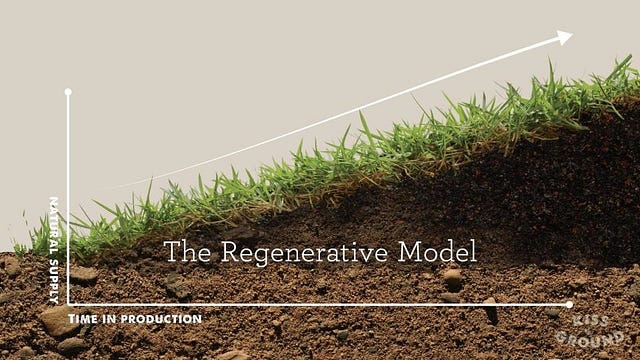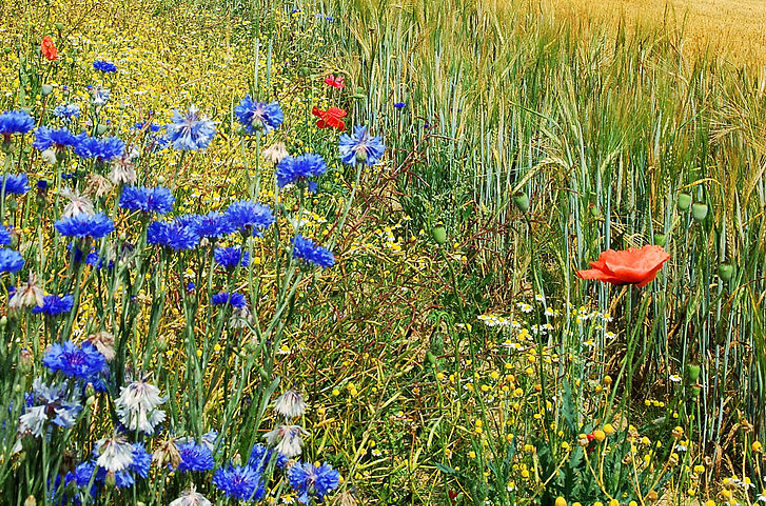Human activities have degraded ecosystems globally to the point that Earth is now in overshoot-and-collapse. We need to restore ecosystem functions in the coming decades in order to safeguard our collective future. This will require us to regenerate the environments on which we depend.
I have been working with the Regenerative Communities Network to cultivate bioregional-scale projects that do this very thing. One of our challenges is that most people have not been trained in regenerative design practices — including how we frame regeneration itself.
The purpose of this article is to lay out some of the ways that regeneration can be framed… helping us conceptualize what we are doing and communicate more effectively with our partners in the field. My intention is not so much to be comprehensive as it is to stimulate further discussion. We need to have conversations about the language we use to work together, especially when conflicts arise and it becomes necessary to navigating through diverse points of view.
For starters, to re-generate means there must previously have been processes or mechanisms for generating outcomes in the first place. All living systems have built-in feedbacks for creating the conditions necessary for their survival. This is done moment-to-moment. It is dynamic.
In a word it is ALIVE.
Every organism must generate its conditions for metabolism and homeostasis. And so every organism must reproduce these conditions in its environment as it goes about its life. Here is the beginning of how we frame regeneration. Consider your skin as a membrane on your body that is necessary for keeping you alive. It has been known for a long time that human skin sheds its cells completely every 30 days — while continuously regenerating the skin tissue in a process of ongoing replacement.
If a person becomes sick (for example, after a severe burn) they may lose this ability to replenish their skin and a cascade of harms quickly follow: shivering, infection, hot flashes, burning sensations, and more. The lack of regeneration is measured as poor health.
So our first framing of regeneration is a living organisms ability to regulate itself and remain healthy as it goes about its daily life.
 A salamander regrowing one of its arms — yes, they can really do this!
A salamander regrowing one of its arms — yes, they can really do this!
It is interesting to think about how stem cell researchers discuss regeneration:
“Regeneration means the regrowth of a damaged or missing organ part from the remaining tissue.”
Some tissues that become damaged are able to regrow. This has been observed with starfish and worms, salamanders and frogs, and yes also for some human tissues like those found in the liver. Here we are talking about an organism’s ability to repair itself. This moves us into the realm of resilience and adaptive responses.
Regeneration can also be framed as the ability for a living system to repair itself after harm has been done. In a management sense, it is about putting in place the feedbacks and learning mechanisms to handle an emergency and respond to it appropriately. Think about what happens to a city that is hit by a hurricane. Can the people living there regenerate the vital functions of their community? What about the food production in a place like Syria where climate change (due to land use practices) has created chronic drought? How can the people living their regenerate the soils and forests to again become self-sufficient?
Now we are getting into the realm of regeneration as it is practiced in human systems. A third way to frame regeneration can be found in the management of agricultural systems:
“Regenerative Agriculture is a system of farming principles and practices that increases biodiversity, enriches soils, improves watersheds, and enhances ecosystem services.”
Note how this third way of framing regeneration is as a management or design framework. With scientific or indigenous knowledge about how to restore landscapes, it becomes possible for humans to intentionally shape their relationships to the land such that regeneration occurs.

Human management choices can alter how landscapes evolve.
Now we are in the realm of thinking in concrete terms about how to deal with planetary overshoot-and-collapse. Restore vital ecosystem functions in the human management systems themselves and the landscapes gain the ability to regenerate themselves. Remove human hands entirely and it is an open question — sometimes regeneration occurs and other times degradation intensifies, depending upon the feedback dynamics of the systems involved.
This opens up an interesting question about spirituality and ethics. How should people find right relationships with their surroundings? I was pleased to discover that regeneration has an essential framing in religious practice too. Here is a quote from a discussion about how regeneration relates to the Bible in the Christian Tradition:
“After regeneration, we begin to see and hear and seek after divine things; we begin to live a life of faith and holiness.”
In a spiritual sense, how we relate to the world (and to ourselves) can either be regenerative or damaging. This framing of regeneration is about cultivating the nourishment of healthy relations with the divine. Live as a spiritual healer and you may also be healed.
I am especially struck by how the scientific and the spiritual achieve frame resonance on this point. A person can come from a religious or scientific perspective and still find common ground — literally — in the direct human relationship to the land upon which our livelihoods depend.
So I leave you to ponder this. How might you bring these frames of regeneration into your daily life? What are you doing currently that hinders the life flow of energy and nutrients to the world around you? What hinders how you nourish your inner world of spirituality and personal ethics?
We humans have not been living in right relationship with the world. Those of us who try still find ourselves dependent on management systems that violate the conditions of thriving for living systems. So we must somehow make a transition from daily routines that do harm to daily enactments that restore and regenerate the world.
Onward, fellow humans.
Teaser photo credit: By I, Luc Viatour, CC BY-SA 3.0





